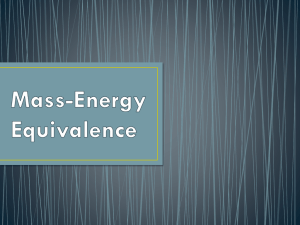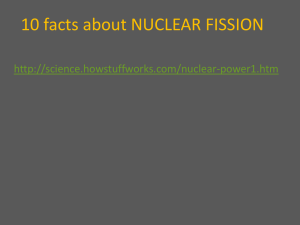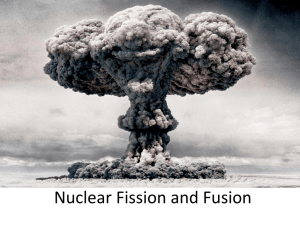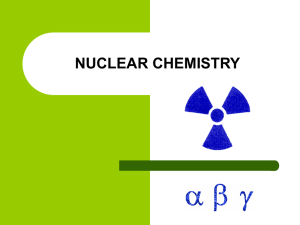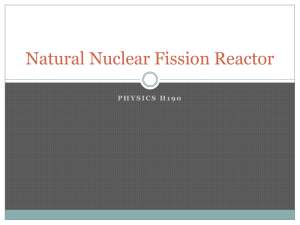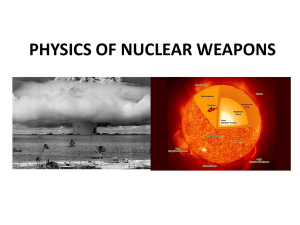TAP527-0: Nuclear transmutation
advertisement
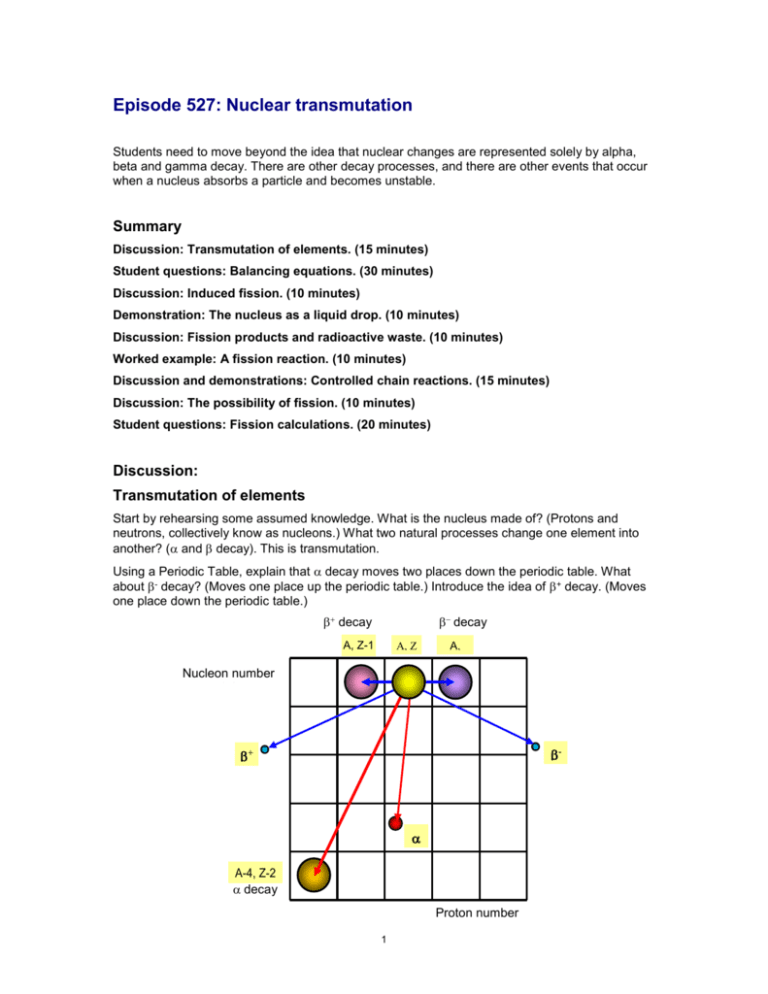
Episode 527: Nuclear transmutation Students need to move beyond the idea that nuclear changes are represented solely by alpha, beta and gamma decay. There are other decay processes, and there are other events that occur when a nucleus absorbs a particle and becomes unstable. Summary Discussion: Transmutation of elements. (15 minutes) Student questions: Balancing equations. (30 minutes) Discussion: Induced fission. (10 minutes) Demonstration: The nucleus as a liquid drop. (10 minutes) Discussion: Fission products and radioactive waste. (10 minutes) Worked example: A fission reaction. (10 minutes) Discussion and demonstrations: Controlled chain reactions. (15 minutes) Discussion: The possibility of fission. (10 minutes) Student questions: Fission calculations. (20 minutes) Discussion: Transmutation of elements Start by rehearsing some assumed knowledge. What is the nucleus made of? (Protons and neutrons, collectively know as nucleons.) What two natural processes change one element into another? ( and decay).This is transmutation. Using a Periodic Table, explain that decay moves two places down the periodic table. What about - decay? (Moves one place up the periodic table.) Introduce the idea of + decay. (Moves one place down the periodic table.) decay decay A, Z A, Z-1 A, Z+1 Nucleon number (A) - + A-4, Z-2 decay Proton number (Z) 1 Write general equations for these processes. There is another way in which an element may be transmuted; for example, the production of radioactive 14C used in radio-carbon dating in the atmosphere by the neutrons in cosmic rays. 14 1 14 1 7 N 0 n 6 C 1H The first artificial transmutation was achieved by Rutherford by bombarding nitrogen with particles. (This experiment was also important in demonstrating that protons are found inside nuclei.) Ask your students to complete the following nuclear equation that summarizes Rutherford’s transmutation of nitrogen into oxygen: He147N O11H They should get 24 He147N 178O11H Cockroft and Walton were the first to ‘split’ the atom, by bombarding lithium with protons from their accelerator. 1 7 8 1 H 3 Li4 Be 2 24 He Student questions: Balancing equations Students can practise balancing equations. TAP 527-1: Isotope production Discussion: Induced fission In the examples above, small parts are ‘chipped off’ nuclei. The behaviour of the heaviest natural element, uranium, is different. It breaks up into two large chunks – into two elements nearer to the middle of the periodic table – so-called induced fission. The two lighter elements are referred to as fission fragments. How do the two common isotopes of uranium 235 92U and 238 92U differ? ( 238 92U has three more 235 238 neutrons than 235 92U .) It is the 92U not the 92U that fissions. It absorbs a neutron, then splits into fission fragments, i.e. any two smaller nuclei that can be made from the 235 nucleons of the 235 92U . TAP 527-2: Nuclear fission Demonstration: The nucleus as a liquid drop In many ways, nuclei behave like a drop of liquid. Show a water filled balloon - a good model for a nucleus. After the absorption of the neutron, the nucleus of 238 92U wobbles. As soon as the electric charge distribution departs from the spherical (pinch the balloon into a dumbbell like shape) the 2 uranium nucleus neutron fission fragments The nuclear chain reaction neutrons (resourcefulphysics.org) mutual coulomb repulsion between the two ends drives the fission process. An alternative is to grease a plate and put a large drop of water on it. Wobble the plate about and watch the drop split. Discussion: Fission products and radioactive waste Most of the energy released is in the form of the kinetic energy of the fission fragments. Because they have a relatively high fraction of neutrons, they are unstable, and decay with short half-lives. They form the ‘high-level’ radioactive waste that cannot be simply disposed of; it has to be stored somewhere for a minimum of 20 half lives. By what factor will the activity fall after 20 half lives? (1/220 is about 10-6, or one-millionth) 137Cs 90Sr has a half life of 30.23 years: 20 half lives = 605 years has a half life of 28.1 years: 20 half lives = 562 years Think about the consequences if waste disposal has to be engineered to remain intact for many centuries. (Which engineering structures have existed for the last 600 years?) Worked example: A fission reaction Here is the nuclear equation for a typical fission process: 1 235 236 138 95 0 n 92U 92 U 53 I 39Y ? What is required to balance the equation? (3 neutrons) Why are there some neutrons left over? (Relate this to the N - Z curve. The heaviest elements have the largest neutron excess to remain stable. The two lighter fission fragments have a higher fractional neutron excess; hence some are ‘left over’.) These ‘left over’ neutrons are the vital key to unlock nuclear power using fission. 3 Discussion + demonstrations: Controlled chain reactions If at least one surplus neutron can induce fission in another 235U nucleus and so on, then a self sustaining release of nuclear energy is possible. For a power station a controlled chain reaction is needed. Should each fission result in more than one further fission, then the chain reaction is said to diverge. In a bomb the aim is to get the chain reaction to diverge as fast as possible. Blow up two balloons; let one fly off; release the other slowly, to illustrate the difference between uncontrolled and controlled energy release. There are a number of analogues of chain reactions that can be demonstrated at this point, using matches or lines of dominoes. TAP 527-3: Chain reactions TAP 527-4: Fission analogues Discussion: The possibility of fission What are the chances that a neutron will strike another nucleus? First recall that atoms are mostly empty space. The nuclei of two adjacent uranium atoms are typically 10,000 nuclear diameters apart. Emphasise this by picking a pupil in the middle of the class, and estimating her/his width (0.3 m?). Where will the next ‘pupil nuclei’ be situated? (3 km away.) A fast-moving neutron will travel a long way before it strikes another nucleus. In fact, most neutrons are absorbed by 238U nuclei, which are much more common than 235U, and quite good at absorbing fast neutrons. Instead of fissioning they transmute into 239Pu which is fissile, the favourite explosive material for making nuclear bombs. Pure natural uranium is incapable of sustaining a fission reaction – less than one fission neutron succeeds in inducing a further fission. Ask your students how this problem might be overcome in order to have a controlled chain reaction. (The answer is the introduction to the next episode.) Student questions: Fission calculations Calculations of energy released in fission events. TAP 527-5: Fission – practice questions 4 TAP 527-1: Isotope production The production of radio-nuclides by nuclear transmutation is now big business. They are for use in medicine (diagnostic and therapy) and industry (imaging, tracers, process monitoring etc) and are made by neutron bombardment in nuclear reactors and by proton, deuteron ( 12 H ) or particle bombardment by accelerators. Complete these equations that represent examples of these processes. 31 32 15 P ?15 P ? 2 17 15 1H 7N 8O ? 4 16 18 2 He 8 O 9 F ? ? 4 121 1 2 He 51Sb ?0 n Find out the half-lives of the isotopes produced in these processes Find out a typical use of these products. 5 Practical advice These questions are to help your students write decay equations and carry out research. Half lives can be found at http://www.kayelaby.npl.co.uk/atomic_and_nuclear_physics/4_6/4_6_1.html Answers 31 15 Isotope Half Life Emitted particle(s) Energy / Mev 32 15 P 14.3 days beta 1.178 15 8O 126 seconds positron 1.7 18 9F 112 minutes positron 0.6 123 53 I 13.2 hours gamma 0.159 32 P15 P 01n Phosphorus-32 is commonly the highest energy radionuclide encountered in a research setting, and thus requires special caution. Exposure should be avoided and handling should be limited as much as possible. http://www.unh.edu/ehs/radsafety/Fact_Sheets/P-32.html A solution of phosphate, containing radioactive phosphorus-32, is injected into the root system of a plant. Since phosphorus-32 behaves identically to that of phosphorus-31, the more common and non-radioactive form of the element, it is used by the plant in the same way. A Geiger counter is then used to detect the movement of the radioactive phosphorus-32 throughout the plant. This information helps scientists understand the detailed mechanism of how plants utilized phosphorus to grow and reproduce. http://www.chem.duke.edu/~jds/cruise_chem/nuclear/agriculture.html 2 17 15 1 1 H 7 N 8 O0 n Air tagged with O15 has been applied to the study in dogs for (a) the kinetics of the transfer of oxygen from pulmonary gases to blood, (b) the rate of incorporation of oxygen into water during metabolism, c) the rate of exchange of plasma water with tissue water http://ajplegacy.physiology.org/cgi/content/abstract/201/3/582 4 2 He 168O189F 11H 01n F-18 is for many reasons a useful radioisotope for bio-medical studies. Physically, the longer half-life (112 min) allows more time for relatively complex synthetic manipulations and for biological studies. In addition, the lowest positron energy, and thus its shortest positron range, 6 allows for the sharpest imaging with a high-resolution PET. http://laxmi.nuc.ucla.edu:8248/M248_98/synprob/part4/org_chem_f.html 4 121 123 2 He 51Sb 53 I 201n The usefulness of iodine-123 whole-body scans in evaluating thyroid cancer http://tech.snmjournals.org/cgi/content/short/27/4/279 Clinical Pharmacology: Sodium Iodide is readily absorbed from the upper gastrointestinal tract. Following absorption, the iodide is distributed primarily within the extracellular fluid of the body. It is concentrated and organically bound by the thyroid and concentrated by the stomach, choroid plexus, and salivary glands. It is also promptly excreted by the kidneys. The normal range of urinary excretion in 24 hours is reported to be 37-75% of the administered dose varying with thyroid and renal function. The iodide-concentrating mechanism of the thyroid, variously termed the iodide “trap” or “pump” accounts for an iodide concentration some 25 times that of the plasma level, but may increase to as much as 500 times under certain conditions. http://www.nuclearonline.org/PI/Nycomed%20I-123%20Na%20I%20capsules.pdf 7 TAP 527- 2: Nuclear fission This sequence shows how to calculate the energy changes as fission occurs. Nuclear fission of uranium-235 neutron comes towards U-235 nucleus U-236 nucleus oscillates like liquid drop U-236 breaks into two pieces electrical repulsion neutron is captured neutron U-235 nucleus U-236 nucleus in excited state electrical repulsion 8 two or three neutrons set free Nuclear fission of uranium-235 Fission takes nucleons down the binding energy valley 0 curve of binding energy as number of nucleons changes U-235 breaks into two unequal fragments of variable size –7.6 235 about 0.9 MeV 133 Coulomb slope 100 –8.8 nucleon number A Nuclear fission of uranium-235 Energy from fission energy per U-235 fission event = 202 MeV fissile nucleus about 0.9 MeV per nucleon energy per nucleon = 202 MeV/235 nucleons = 0.86 MeV per nucleon fission products 9 Practical advice These diagrams are reproduced here so that you can use them for discussion with your class. External reference This activity is taken from Advancing Physics chapter 18, 110O 10 TAP 527- 3: Chain reactions 11 Practical advice These diagrams are reproduced here so that you can use them for discussion with your class. External reference This activity is taken from Advancing Physics chapter 18, 120O 12 TAP 527- 4: Fission analogues 1. Controlled energy release Air filled balloons can be used to show the difference between the controlled release of energy and an uncontrolled explosion, to mimic the controlled chain reaction or the diverging chain reaction (used in a nuclear bomb). Inflate two balloons and tie the necks. On one stick a piece of sellotape about 5 cm long. When holding the balloon by the neck, have the sellotape facing upwards. Take a good-sized pin (a ray tracing optics pin is ideal). Burst one balloon with the pin – the uncontrolled energy release. To ham up the demo, now claim that by pushing the pin very carefully into the balloon it is possible not to burst the balloon and thus achieve a controlled energy release. Slowly push the pin into the sellotaped portion of the balloon. Stop when the pin is still sticking out of the balloon. Then remove the pin slowly. Keep checking during the rest of the lesson to monitor the slow deflation of the balloon. 2. Diverging chain reaction Set up dominoes on edge in the form of a triangle, so that when a domino at the apex is pushed over, it hits two dominoes, they hit 3, which hit 4, and so on. Alternatively: Drill a piece of wood with a triangular array of small holes to hold matches, ‘live’ end upper most. Arrange the spacing so that one lighted match can ignite its neighbours in the next row. Ten rows are ample. Set the board upright, with the apex of the triangle at the bottom. Light the match at the apex, and see the diverging chain reaction. ! Safety assessment! Try it by yourself first to see what to expect. Have a fire extinguisher handy (it helps to hype up the demo). Beware any heat or smoke alarms that might be activated. Extinguish by blowing out – ask if anybody in the audience has a birthday today, or close to the actual date, to volunteer. For a controlled chain reaction: use a simple line of dominoes or matches. 13 Practical advice These analogues are provided so you can make a choice of demonstration(s) or activities. 14 TAP 527- 5: Fission – practice questions What these are for These questions will give you some simple practice in handling the ideas and calculations that physicists meet in nuclear fission. Try these The process of fission in one type of nuclear reactor proceeds as follows: a nucleus of uranium 235 92 U captures a single neutron. The resulting nucleus is unstable and splits into two or more 90 144 fragments. These fragments could typically be a pair of nuclei, 36 Kr and 56 Ba for example. Neutrons are also ejected as a result of the fission. It is these neutrons that go on to cause subsequent fission events and maintain the chain reaction. 1. Write down two balanced equations (the first to the unstable uranium; the second to the final products) that represent this fission process. 2. Calculate the total mass of the original uranium isotope and the neutron. The table gives the atomic masses (in atomic mass units) of the particles found in this question. (1 atomic mass unit (u) 931 MeV.) Particle Mass (u) 1 0n 1.008 665 90 36 Kr 89.919 528 92 36 Kr 91.926 153 96 37 Rb 95.934 284 138 55 Cs 137.911 011 138 56 Ba 137.905 241 144 56 Ba 143.922 941 235 92 U 235.043 923 15 3. Calculate the total mass of the four products. 4. Calculate the change in mass. Does this represent energy gained or lost by the system? 5. Convert the mass change into the energy released (in MeV) in the fission event. 6. These particular barium and krypton isotopes are not the only products possible in nuclear fission. Repeat the calculation steps 1–5 with the following possible products caesium-138 and rubidium-96. Hints 1. There are two equations, the first for the absorption of the neutron; the second for the splitting of the unstable nucleus formed in the absorption. Write down all the original nucleons on the left-hand side of the first equation (do not forget the original neutron). Put all the products on the right-hand side. Check that all protons, neutrons and electrons balance. Energy is also an output of the reaction, call it Q. 2. Add the atomic mass unit values for the uranium and the neutron together. 3. Add the atomic mass unit values for the barium, krypton and two neutrons together. 5. Use E = mc2 to carry out this conversion. c2 = 9 x 1016 J kg–1. 16 Practical advice This question set provides repetitive practice in handling nuclear mass changes and conversions between mass and energy. It is suitable for students meeting these ideas for the first time. There is an energy release / nucleon perspective here – a useful teaching point when students have completed this task Answers and worked solutions 1 0n 236 92 U 90 36 Kr 144 56 Ba 201 n Q 1. 235 92 U 2. m = 235.043923 u – 1.008665 u = 236.052 588 u 3. m = 89.919528 u + 143.922941 u + 1.008665 u + 1.008665 u =235.859 799 u 4. m =236.052 588 u – 235.859799 u = 0.192 789 u; energy lost 5. E = 0.192 789 u × 931.3 MeV u 6. m = 137.905241 u + 95.934284 u + 1.008665 u + 1.008665 u =235.856855 u m = 236.052 588 u – 235.856855 u = 0.195733 u E = 0.195733 u × 931.3 MeV u –1 –1 =179.49 MeV = 182.2 MeV External reference This activity is taken from Advancing Physics chapter 18, 250S 17



